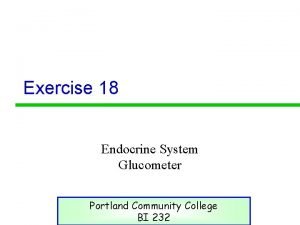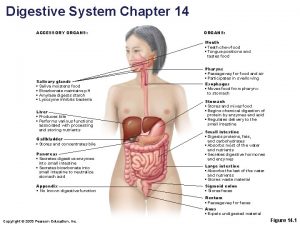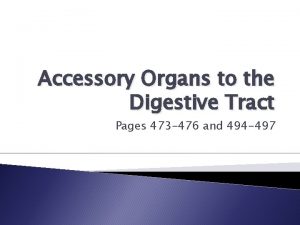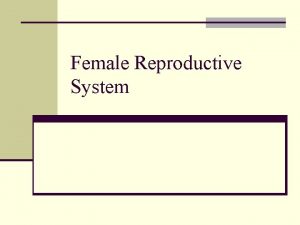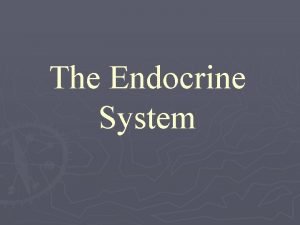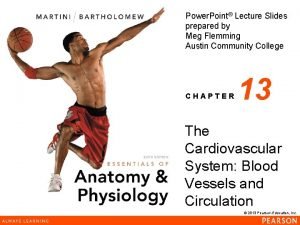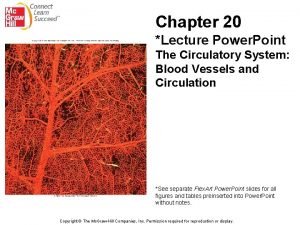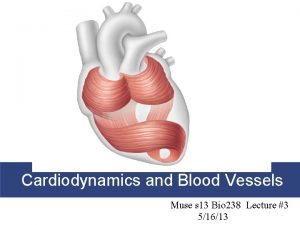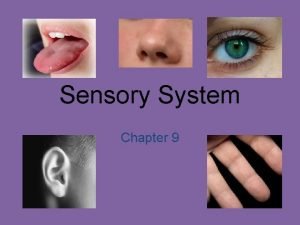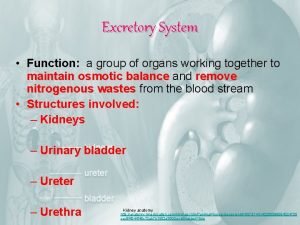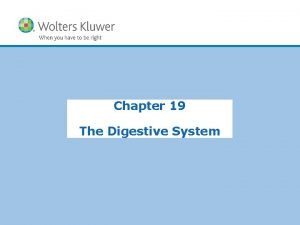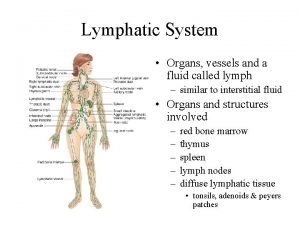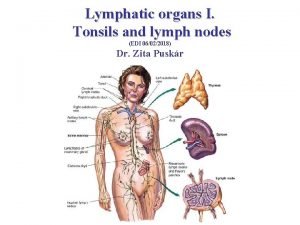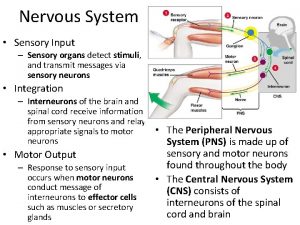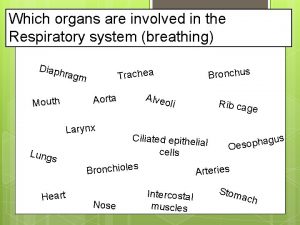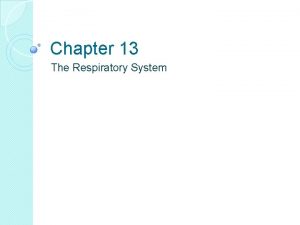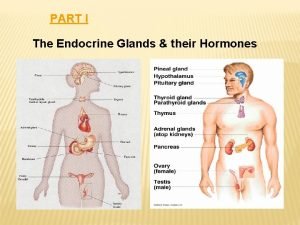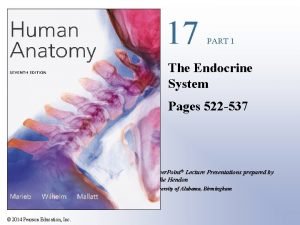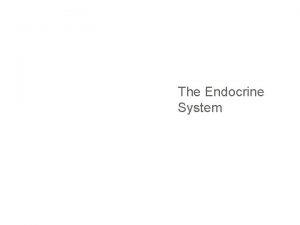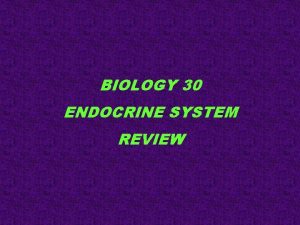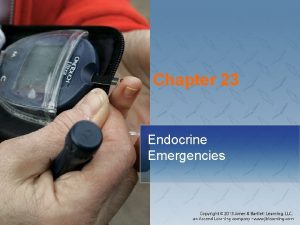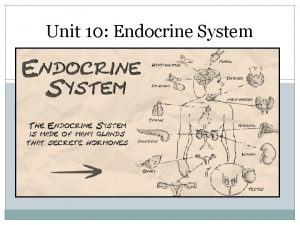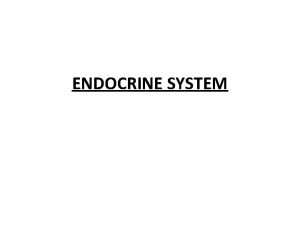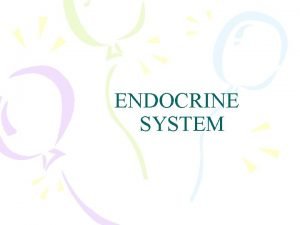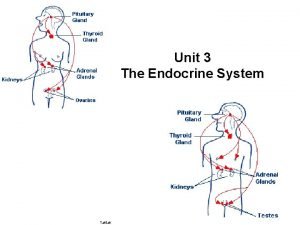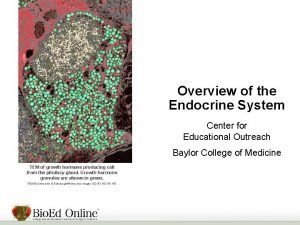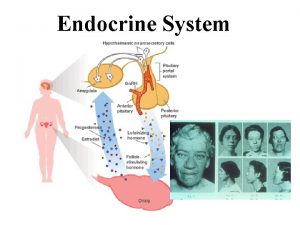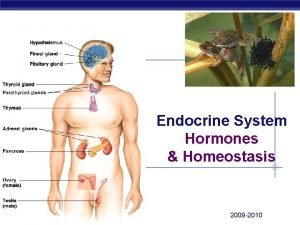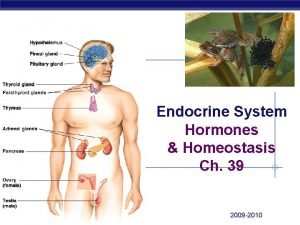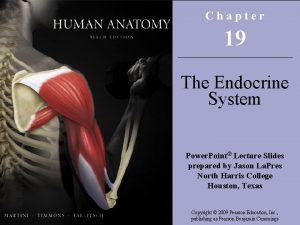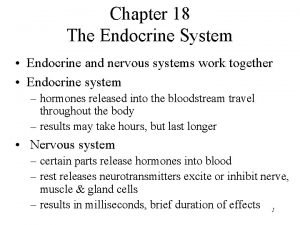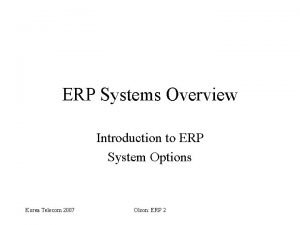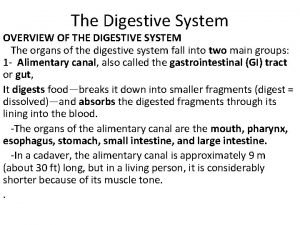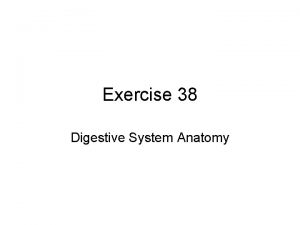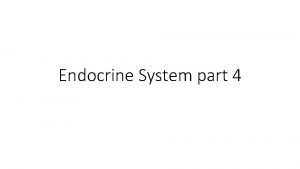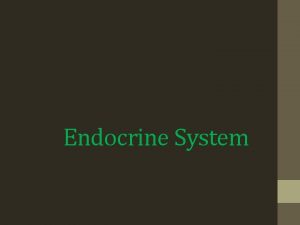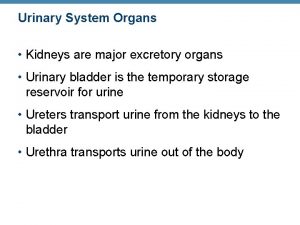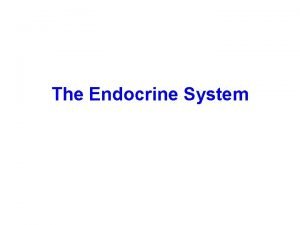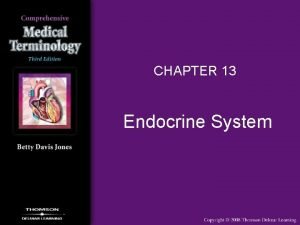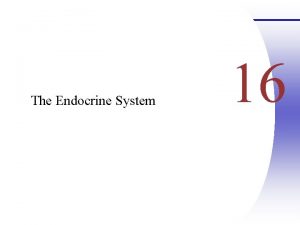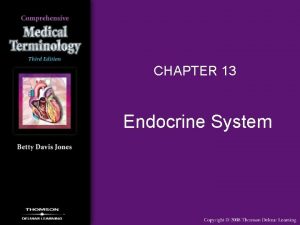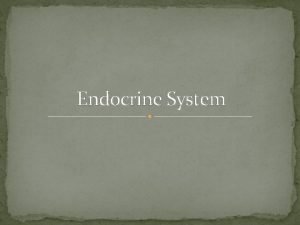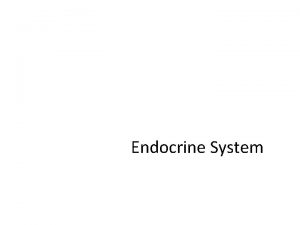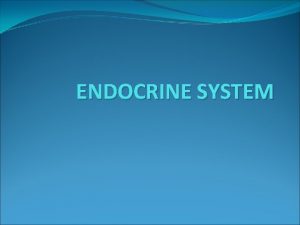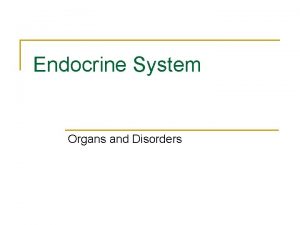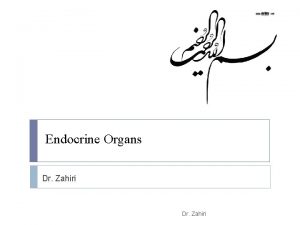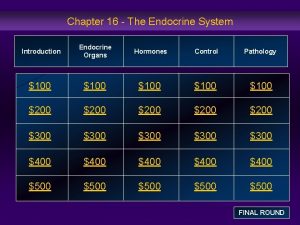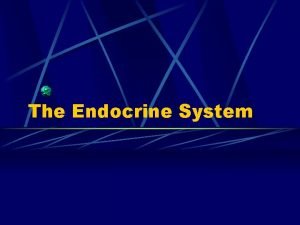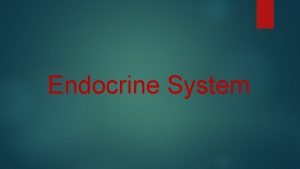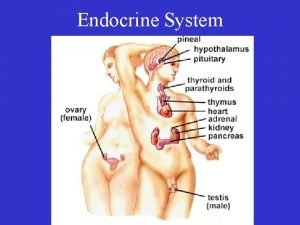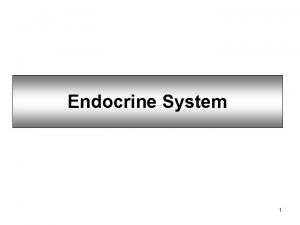Endocrine System Endocrine Major System Endocrine Overview Organs
































































- Slides: 64

Endocrine System

Endocrine Major System Endocrine Overview Organs Hormone Major Endocrine Disorders Organs Hormone Disorders Other Category 1 Category 2 Category 3 Category 4 Category 5 Category 6 500 500 500 400 400 400 300 300 300 200 200 200 100 100 100 Final Jeopardy Question

Lipid soluble steroid hormones do all of the following except: A) Diffuse through the plasma membrane of target B) Enter the nucleus C) Catalyze cyclic AMP (c. AMP) D) Bind to receptor proteins within cell/nucleus Answer Back

Answer = C Steroids do not need to use a second messenger like c. AMP. Back

Name and describe the two mechanisms of hormone action (based on the chemical class of the hormone). Answer Back

Steroid hormone action (Class-steroid based, lipid-soluble) (Direct gene activation) and Nonsteroid hormone action (Class-amino acid based, water soluble) (Second-messenger system) Back

Name the 3 major categories of stimuli that activate the endocrine organs. Answer Back

Hormonal, humoral, and neural (Hint: This is essay question. List and describe!) Back

This mechanism is the chief means of regulating blood levels of nearly all hormones. Answer Back

Negative feedback mechanism Back

Defined as chemical substances that are secreted by endocrine cells into the extracellular fluid, these molecules are usually transported by the blood to their target cells/organs. Answer Back

Hormones Back

These 6 hormones are produced by the anterior lobe of the pituitary gland. Answer Back

Growth hormone (GH) Prolactin (PRL) Follicle-stimulating hormone (FSH) Luteinizing hormone (LH) Thyroid-stimulating hormone (TSH) Adrenocorticotropic hormone (ACTH) Back

Antidiuretic hormone (ADH) is also called by this name due to its ability to increase blood pressure by constricting arterioles. Answer Back

Vasopressin Back

These 2 hormones work together to control blood sugar level and are formed from these Islets of Langerhans cells of the pancreas respectively. Answer Back

Insulin, beta cells Glucagon, alpha cells Back

This hormone’s primary functions are to trigger ovulation in females and to stimulate testosterone production in males. Answer Back

Luteininzing hormone (LH) Back

This hormone stimulates follicle development in the ovaries (ova) and testis (sperm). Answer Back

Follicle stimulating hormone (FSH) Back

This hormone promotes the reabsorption of sodium by the kidney tubules back into the blood. Answer Back

Aldosterone Back

This group of adrenal cortex hormones increase blood glucose levels, suppress inflammation and decrease edema. Answer Back

Glucocorticoids (cortisol and cortisone) Back

The functions of this hormone include stimulation of uterine contractions, breast milk ejection, and labor induction. Answer Back

Oxytocin Back

This hormone produced by the pineal gland helps to regulate our sleep/wake cycle. Answer Back

Melatonin Back

The maturation of white blood cells known as T lymphocytes is controlled by thymosin which is produced by this endocrine gland. Answer Back

Thymus gland Back

Hypersecretion of this hormone (usually caused by a tumor) may produce Graves’ disease; characterized by bulging eyes, high basal metabolic rate (BMR), rapid heartbeat, and agitation. Answer Back

Thyroid hormones: Thyroxine (T 4) and Triiodothyronine (T 3) Back

Hyposecretion of this hormone may cause cretinism in the child with some retardation and myxedema in the adult with mental sluggishness. Answer Back

Thyroid hormones: Thyroxine (T 4) and Triiodothyronine (T 3) Back

Hyposecretion of Antidiuretic hormone (ADH) leads to this condition which is characterized by excessive urine output. Answer Back

Diabetes insipidus Back

Hyposecretion of this hormone leads to diabetes mellitus. This can cause acidosis when fat has to be used for energy. Answer Back

Insulin Back

This disorder occurs due to the hypersecretion of growth hormone in children. Answer Back

Gigantism Back

Hyposecretion of the mineralocorticoids (and glucocorticoids) leads to this disease that can be characterized by a peculiar bronzing of the skin. Answer Back

Addison’s disease Back

Hypersecretion of the glucocorticoids leads to this disease of which symptoms may include “buffalo hump, ” “moon face, ” hypertension and hyperglycemia. Answer Back

Cushing’s syndrome Back

Hypersecretion of growth hormone in the adult causes this disorder which is characterized by enlargement of the face, feet and hands. Answer Back

Acromegaly Back

This disorder is characterized by a standing height of less than 4 feet and normal body proportions Answer Back

Pituitary dwarfism Back

Steps taken to prevent this disorder included the addition of iodine to salt. Answer Back

Goiter Back

Category 6 500 pts Enter question here These descriptors are known as the 3 cardinal signs of diabetes. Answer Back

Polyuria, polydipsia and polyphagia Back

This hormone is produced by the developing embryo to prevent menses and its later production is taken over by the placenta. Answer Back

Human Chorionic Gonadotropin (h. CG) Back

This enzyme, produced by the kidneys when blood pressure is too low for proper filtration, stimulates the release of aldosterone from the adrenal cortex. Answer Back

Renin Back

These 2 hormones, collectively called catacholamines, are Enter question here produced from the adrenal medulla under direct SNS stimulation. Answer Back

Epinephrine and norepinephrine Back

These 3 hormones are produced by the gonads, ovaries and testis, respectively. Answer Back

Ovaries: Estrogen and progesterone Testis: Testosterone Back

Enter question here These are the 5 major processes controlled by hormones. Answer Back

1. Reproduction 2. Growth and development 3. Mobilization of body defenses (against stressors) 4. Maintenance of homeostasis in blood (water, electrolytes, & nutrients) 5. Regulation of metabolism (cellular metabolism & energy balance)
 Major endocrine glands male and female
Major endocrine glands male and female Endocrine organs
Endocrine organs Function of the organs in the digestive system
Function of the organs in the digestive system Accessory organs
Accessory organs Main function of major organs
Main function of major organs Major plant organs
Major plant organs Major endocrine glands male and female
Major endocrine glands male and female Systemic artery
Systemic artery Blood supply of stomach flowchart
Blood supply of stomach flowchart Arteries of abdomen
Arteries of abdomen Overview of the major systemic arteries
Overview of the major systemic arteries Endocrine system and reproductive system
Endocrine system and reproductive system Endocrine system and nervous system
Endocrine system and nervous system Lymphatic system vs endocrine system
Lymphatic system vs endocrine system Endocrine vs nervous system venn diagram
Endocrine vs nervous system venn diagram Endocrine system and nervous system
Endocrine system and nervous system Sensory system organs
Sensory system organs Function of the excretory system
Function of the excretory system Accessory organs of the digestive system
Accessory organs of the digestive system Lymphatic system organs and functions
Lymphatic system organs and functions Formation of lymph
Formation of lymph Lymphatic tissue
Lymphatic tissue Function of lymphatic system
Function of lymphatic system Organs of the sensory system
Organs of the sensory system Which organs are involved in respiratory system
Which organs are involved in respiratory system Chapter 13 the respiratory system
Chapter 13 the respiratory system Adenohypophysis
Adenohypophysis Differences between nervous system and endocrine
Differences between nervous system and endocrine Comparison of endocrine and nervous system
Comparison of endocrine and nervous system Gonads glands
Gonads glands Facts about the endocrine system
Facts about the endocrine system Endocrine system of rat
Endocrine system of rat Tropic hormones hypothalamus
Tropic hormones hypothalamus Endocrine system pearson
Endocrine system pearson Exocrine glands are ductless
Exocrine glands are ductless Chapter 7:13 endocrine system
Chapter 7:13 endocrine system Stimulus endocrine system
Stimulus endocrine system Figure of endocrine system
Figure of endocrine system Hypothal
Hypothal Biology 30 endocrine system
Biology 30 endocrine system Site:slidetodoc.com
Site:slidetodoc.com Chapter 23 the endocrine system
Chapter 23 the endocrine system Endocrine system analogy
Endocrine system analogy Endocrine system introduction
Endocrine system introduction Classification of hormones
Classification of hormones T4.taktak
T4.taktak Endocrine system
Endocrine system Endocrine system
Endocrine system Pancreas in endocrine system
Pancreas in endocrine system Endocrine glands
Endocrine glands Endocrine system
Endocrine system Chapter 16 lesson 3 the female reproductive system
Chapter 16 lesson 3 the female reproductive system Endocrine system regents questions
Endocrine system regents questions Endocrine system regents questions
Endocrine system regents questions Chapter 45 hormones and the endocrine system
Chapter 45 hormones and the endocrine system Endocrine tissues
Endocrine tissues Chapter 18: the endocrine system answer key
Chapter 18: the endocrine system answer key Erp system introduction
Erp system introduction Database content management system
Database content management system Overview of computerized accounting system
Overview of computerized accounting system Overview of the digestive system
Overview of the digestive system Sap ps overview
Sap ps overview Operating system overview
Operating system overview Gym management system database
Gym management system database Anatomy of the digestive system exercise 38
Anatomy of the digestive system exercise 38

